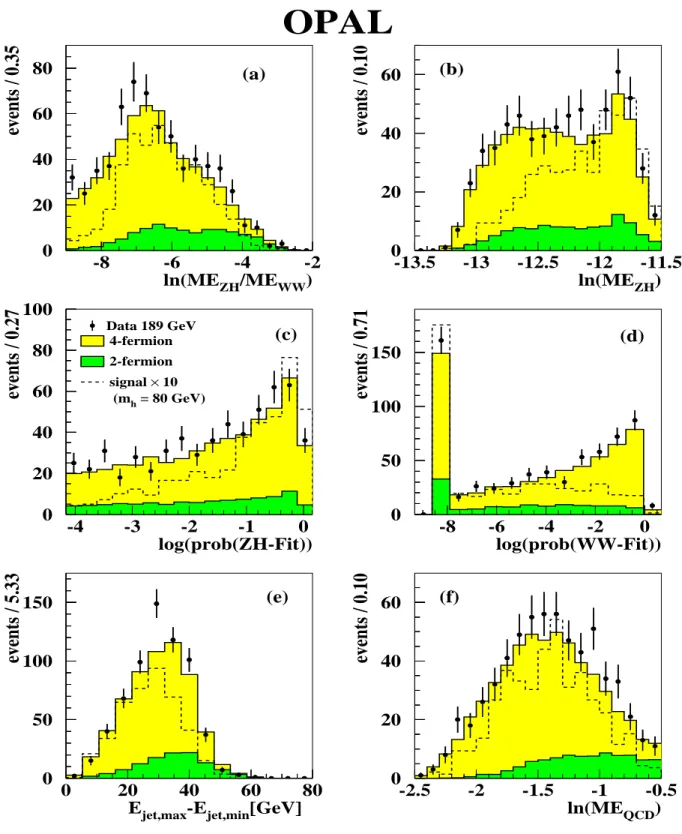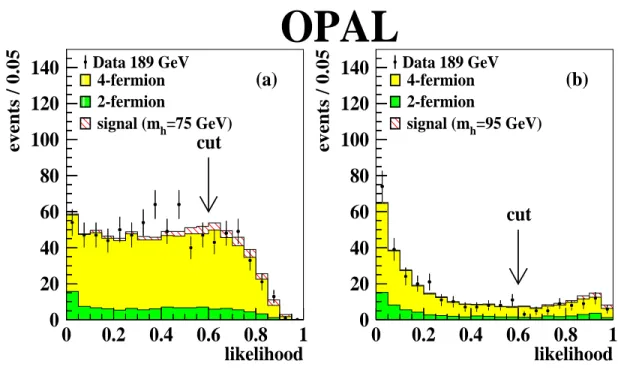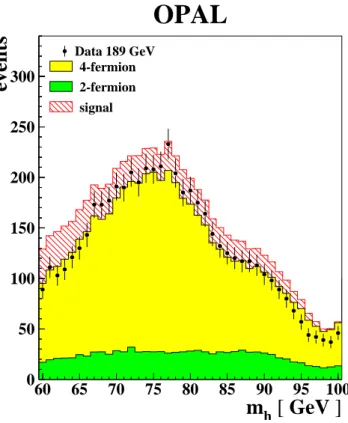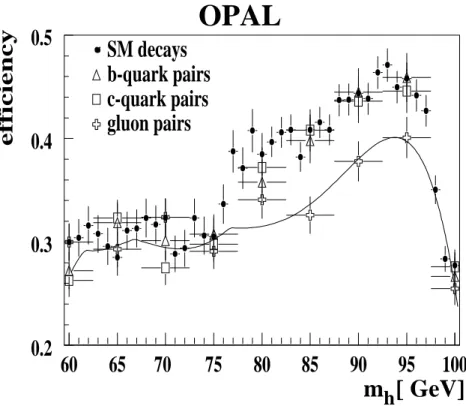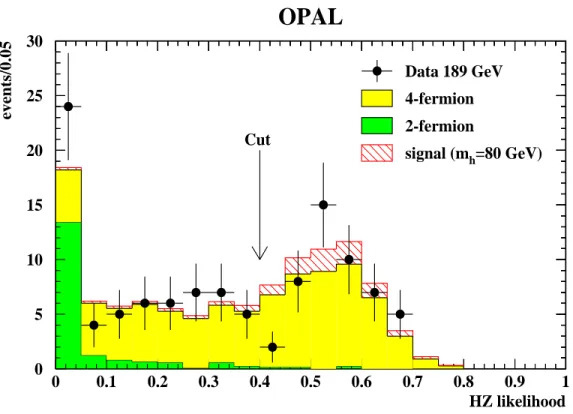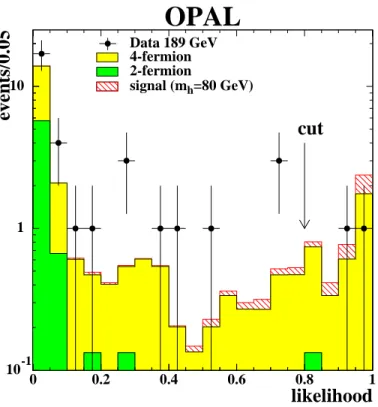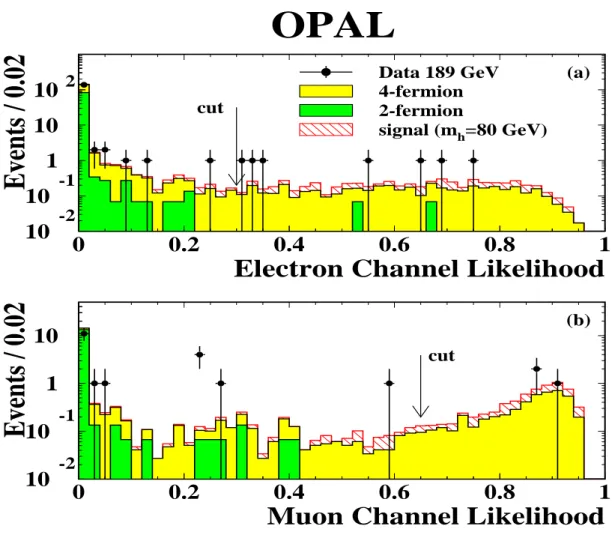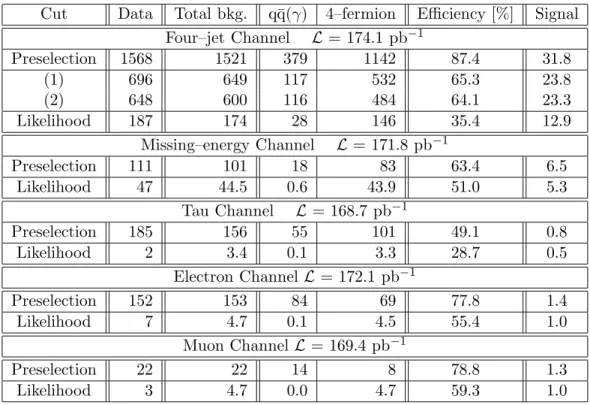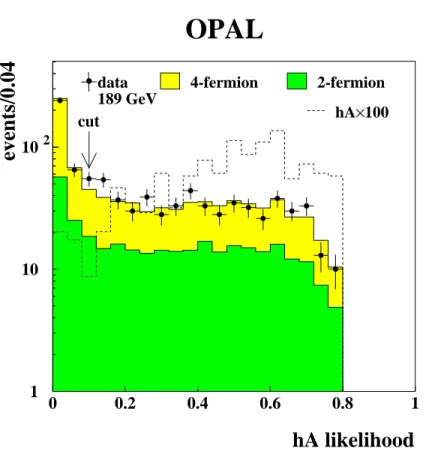arXiv:hep-ex/0007040v1 20 Jul 2000
EUROPEAN ORGANIZATION FOR NUCLEAR RESEARCH
CERN-EP-2000-092 July 7, 2000
Two Higgs Doublet Model and Model Independent Interpretation of Neutral Higgs Boson Searches
The OPAL Collaboration
Abstract
Searches for the neutral Higgs bosons h 0 and A 0 are used to obtain limits on the Type II Two Higgs Doublet Model (2HDM(II)) with no CP–violation in the Higgs sector and no additional particles besides the five Higgs bosons. The analysis combines approximately 170 pb −1 of data collected with the OPAL detector at √
s ≈ 189 GeV with previous runs at √
s ≈ m Z and √
s ≈ 183 GeV. The searches are sensitive to the h 0 , A 0 → q¯q, gg, τ + τ − and h 0 → A 0 A 0 decay modes of the Higgs bosons. For the first time, the 2HDM(II) parameter space is explored in a detailed scan, and new flavour independent analyses are applied to examine regions in which the neutral Higgs bosons decay predominantly into light quarks or gluons. Model–independent limits are also given.
(Submitted to European Physical Journal C)
The OPAL Collaboration
G. Abbiendi 2 , K. Ackerstaff 8 , C. Ainsley 5 , P.F. ˚ Akesson 3 , G. Alexander 22 , J. Allison 16 , K.J. Anderson 9 , S. Arcelli 17 , S. Asai 23 , S.F. Ashby 1 , D. Axen 27 , G. Azuelos 18,a , I. Bailey 26 ,
A.H. Ball 8 , E. Barberio 8 , R.J. Barlow 16 , S. Baumann 3 , T. Behnke 25 , K.W. Bell 20 , G. Bella 22 , A. Bellerive 9 , G. Benelli 2 , S. Bentvelsen 8 , S. Bethke 32 , O. Biebel 32 , I.J. Bloodworth 1 , O. Boeriu 10 , P. Bock 11 , J. B¨ohme 14,h , D. Bonacorsi 2 , M. Boutemeur 31 ,
S. Braibant 8 , P. Bright-Thomas 1 , L. Brigliadori 2 , R.M. Brown 20 , H.J. Burckhart 8 , J. Cammin 3 , P. Capiluppi 2 , R.K. Carnegie 6 , A.A. Carter 13 , J.R. Carter 5 , C.Y. Chang 17 ,
D.G. Charlton 1,b , P.E.L. Clarke 15 , E. Clay 15 , I. Cohen 22 , O.C. Cooke 8 , J. Couchman 15 , C. Couyoumtzelis 13 , R.L. Coxe 9 , A. Csilling 15,j , M. Cuffiani 2 , S. Dado 21 , G.M. Dallavalle 2 ,
S. Dallison 16 , A. de Roeck 8 , E. de Wolf 8 , P. Dervan 15 , K. Desch 25 , B. Dienes 30,h , M.S. Dixit 7 , M. Donkers 6 , J. Dubbert 31 , E. Duchovni 24 , G. Duckeck 31 , I.P. Duerdoth 16 , P.G. Estabrooks 6 , E. Etzion 22 , F. Fabbri 2 , M. Fanti 2 , L. Feld 10 , P. Ferrari 12 , F. Fiedler 8 ,
I. Fleck 10 , M. Ford 5 , A. Frey 8 , A. F¨ urtjes 8 , D.I. Futyan 16 , P. Gagnon 12 , J.W. Gary 4 , G. Gaycken 25 , C. Geich-Gimbel 3 , G. Giacomelli 2 , P. Giacomelli 8 , D. Glenzinski 9 , J. Goldberg 21 , C. Grandi 2 , K. Graham 26 , E. Gross 24 , J. Grunhaus 22 , M. Gruw´e 25 , P.O. G¨ unther 3 , C. Hajdu 29 , G.G. Hanson 12 , M. Hansroul 8 , M. Hapke 13 , K. Harder 25 , A. Harel 21 , M. Harin-Dirac 4 , A. Hauke 3 , M. Hauschild 8 , C.M. Hawkes 1 , R. Hawkings 8 ,
R.J. Hemingway 6 , C. Hensel 25 , G. Herten 10 , R.D. Heuer 25 , J.C. Hill 5 , A. Hocker 9 , K. Hoffman 8 , R.J. Homer 1 , A.K. Honma 8 , D. Horv´ath 29,c , K.R. Hossain 28 , R. Howard 27 , P. H¨ untemeyer 25 , P. Igo-Kemenes 11 , K. Ishii 23 , F.R. Jacob 20 , A. Jawahery 17 , H. Jeremie 18 ,
C.R. Jones 5 , P. Jovanovic 1 , T.R. Junk 6 , N. Kanaya 23 , J. Kanzaki 23 , G. Karapetian 18 , D. Karlen 6 , V. Kartvelishvili 16 , K. Kawagoe 23 , T. Kawamoto 23 , R.K. Keeler 26 , R.G. Kellogg 17 , B.W. Kennedy 20 , D.H. Kim 19 , K. Klein 11 , A. Klier 24 , S. Kluth 32 , T. Kobayashi 23 , M. Kobel 3 , T.P. Kokott 3 , S. Komamiya 23 , R.V. Kowalewski 26 , T. Kress 4 ,
P. Krieger 6 , J. von Krogh 11 , T. Kuhl 3 , M. Kupper 24 , P. Kyberd 13 , G.D. Lafferty 16 , H. Landsman 21 , D. Lanske 14 , I. Lawson 26 , J.G. Layter 4 , A. Leins 31 , D. Lellouch 24 , J. Letts 12 , L. Levinson 24 , R. Liebisch 11 , J. Lillich 10 , B. List 8 , C. Littlewood 5 , A.W. Lloyd 1 ,
S.L. Lloyd 13 , F.K. Loebinger 16 , G.D. Long 26 , M.J. Losty 7 , J. Lu 27 , J. Ludwig 10 , A. Macchiolo 18 , A. Macpherson 28,m , W. Mader 3 , S. Marcellini 2 , T.E. Marchant 16 ,
A.J. Martin 13 , J.P. Martin 18 , G. Martinez 17 , T. Mashimo 23 , P. M¨attig 24 , W.J. McDonald 28 , J. McKenna 27 , T.J. McMahon 1 , R.A. McPherson 26 , F. Meijers 8 , P. Mendez-Lorenzo 31 , W. Menges 25 , F.S. Merritt 9 , H. Mes 7 , A. Michelini 2 , S. Mihara 23 ,
G. Mikenberg 24 , D.J. Miller 15 , W. Mohr 10 , A. Montanari 2 , T. Mori 23 , K. Nagai 8 , I. Nakamura 23 , H.A. Neal 12,f , R. Nisius 8 , S.W. O’Neale 1 , F.G. Oakham 7 , F. Odorici 2 , H.O. Ogren 12 , A. Oh 8 , A. Okpara 11 , M.J. Oreglia 9 , S. Orito 23 , G. P´asztor 8,j , J.R. Pater 16 ,
G.N. Patrick 20 , J. Patt 10 , P. Pfeifenschneider 14,i , J.E. Pilcher 9 , J. Pinfold 28 , D.E. Plane 8 , B. Poli 2 , J. Polok 8 , O. Pooth 8 , M. Przybycie´ n 8,d , A. Quadt 8 , C. Rembser 8 , P. Renkel 24 , H. Rick 4 , N. Rodning 28 , J.M. Roney 26 , S. Rosati 3 , K. Roscoe 16 , A.M. Rossi 2 , Y. Rozen 21 ,
K. Runge 10 , O. Runolfsson 8 , D.R. Rust 12 , K. Sachs 6 , T. Saeki 23 , O. Sahr 31 , E.K.G. Sarkisyan 22 , C. Sbarra 26 , A.D. Schaile 31 , O. Schaile 31 , P. Scharff-Hansen 8 , M. Schr¨oder 8 , M. Schumacher 25 , C. Schwick 8 , W.G. Scott 20 , R. Seuster 14,h , T.G. Shears 8,k ,
B.C. Shen 4 , C.H. Shepherd-Themistocleous 5 , P. Sherwood 15 , G.P. Siroli 2 , A. Skuja 17 ,
A.M. Smith 8 , G.A. Snow 17 , R. Sobie 26 , S. S¨oldner-Rembold 10,e , S. Spagnolo 20 ,
M. Sproston 20 , A. Stahl 3 , K. Stephens 16 , K. Stoll 10 , D. Strom 19 , R. Str¨ohmer 31 ,
L. Stumpf 26 , B. Surrow 8 , S.D. Talbot 1 , S. Tarem 21 , R.J. Taylor 15 , R. Teuscher 9 ,
M. Thiergen 10 , J. Thomas 15 , M.A. Thomson 8 , E. Torrence 9 , S. Towers 6 , D. Toya 23 , T. Trefzger 31 , I. Trigger 8 , Z. Tr´ocs´anyi 30,g , E. Tsur 22 , M.F. Turner-Watson 1 , I. Ueda 23 ,
B. Vachon26, P. Vannerem 10 , M. Verzocchi 8 , H. Voss 8 , J. Vossebeld 8 , D. Waller 6 , C.P. Ward 5 , D.R. Ward 5 , P.M. Watkins 1 , A.T. Watson 1 , N.K. Watson 1 , P.S. Wells 8 , T. Wengler 8 , N. Wermes 3 , D. Wetterling 11 J.S. White 6 , G.W. Wilson 16 , J.A. Wilson 1 ,
T.R. Wyatt 16 , S. Yamashita 23 , V. Zacek 18 , D. Zer-Zion 8,l
1 School of Physics and Astronomy, University of Birmingham, Birmingham B15 2TT, UK
2 Dipartimento di Fisica dell’ Universit`a di Bologna and INFN, I-40126 Bologna, Italy
3 Physikalisches Institut, Universit¨at Bonn, D-53115 Bonn, Germany
4 Department of Physics, University of California, Riverside CA 92521, USA
5 Cavendish Laboratory, Cambridge CB3 0HE, UK
6 Ottawa-Carleton Institute for Physics, Department of Physics, Carleton University, Ot- tawa, Ontario K1S 5B6, Canada
7 Centre for Research in Particle Physics, Carleton University, Ottawa, Ontario K1S 5B6, Canada
8 CERN, European Organisation for Nuclear Research, CH-1211 Geneva 23, Switzerland
9 Enrico Fermi Institute and Department of Physics, University of Chicago, Chicago IL 60637, USA
10 Fakult¨at f¨ ur Physik, Albert Ludwigs Universit¨at, D-79104 Freiburg, Germany
11 Physikalisches Institut, Universit¨at Heidelberg, D-69120 Heidelberg, Germany
12 Indiana University, Department of Physics, Swain Hall West 117, Bloomington IN 47405, USA
13 Queen Mary and Westfield College, University of London, London E1 4NS, UK
14 Technische Hochschule Aachen, III Physikalisches Institut, Sommerfeldstrasse 26-28, D- 52056 Aachen, Germany
15 University College London, London WC1E 6BT, UK
16 Department of Physics, Schuster Laboratory, The University, Manchester M13 9PL, UK
17 Department of Physics, University of Maryland, College Park, MD 20742, USA
18 Laboratoire de Physique Nucl´eaire, Universit´e de Montr´eal, Montr´eal, Quebec H3C 3J7, Canada
19 University of Oregon, Department of Physics, Eugene OR 97403, USA
20 CLRC Rutherford Appleton Laboratory, Chilton, Didcot, Oxfordshire OX11 0QX, UK
21 Department of Physics, Technion-Israel Institute of Technology, Haifa 32000, Israel
22 Department of Physics and Astronomy, Tel Aviv University, Tel Aviv 69978, Israel
23 International Centre for Elementary Particle Physics and Department of Physics, Uni- versity of Tokyo, Tokyo 113-0033, and Kobe University, Kobe 657-8501, Japan
24 Particle Physics Department, Weizmann Institute of Science, Rehovot 76100, Israel
25 Universit¨at Hamburg/DESY, II Institut f¨ ur Experimental Physik, Notkestrasse 85, D- 22607 Hamburg, Germany
26 University of Victoria, Department of Physics, P O Box 3055, Victoria BC V8W 3P6, Canada
27 University of British Columbia, Department of Physics, Vancouver BC V6T 1Z1, Canada
28 University of Alberta, Department of Physics, Edmonton AB T6G 2J1, Canada
29 Research Institute for Particle and Nuclear Physics, H-1525 Budapest, P O Box 49, Hungary
30 Institute of Nuclear Research, H-4001 Debrecen, P O Box 51, Hungary
31 Ludwigs-Maximilians-Universit¨at M¨ unchen, Sektion Physik, Am Coulombwall 1, D- 85748 Garching, Germany
32 Max-Planck-Institute f¨ ur Physik, F¨ohring Ring 6, 80805 M¨ unchen, Germany
a and at TRIUMF, Vancouver, Canada V6T 2A3
b and Royal Society University Research Fellow
c and Institute of Nuclear Research, Debrecen, Hungary
d and University of Mining and Metallurgy, Cracow
e and Heisenberg Fellow
f now at Yale University, Dept of Physics, New Haven, USA
g and Department of Experimental Physics, Lajos Kossuth University, Debrecen, Hungary
h and MPI M¨ unchen
i now at MPI f¨ ur Physik, 80805 M¨ unchen
j and Research Institute for Particle and Nuclear Physics, Budapest, Hungary
k now at University of Liverpool, Dept of Physics, Liverpool L69 3BX, UK
l and University of California, Riverside, High Energy Physics Group, CA 92521, USA
m and CERN, EP Div, 1211 Geneva 23.
1 Introduction
In this study approximately 170 pb −1 of the data 1 collected by the OPAL detector at LEP at 189 GeV centre-of-mass energy are combined with 58 pb −1 of data taken at the Z 0 pole and 53 pb −1 of data at √
s ≈ 183 GeV to search for neutral Higgs bosons [1, 2, 3]
in the framework of the Type II Two Higgs Doublet Model with no CP–violation in the Higgs sector and no additional particles besides those arising from the Higgs mechanism (2HDM(II)) [4, 5]. A model–independent scheme, in which no assumption is made on the structure of the Higgs sector, is also analysed.
In the minimal Standard Model (SM) the Higgs sector comprises only one complex Higgs doublet [1] resulting in one physical neutral Higgs scalar whose mass is a free pa- rameter of the theory. However, since there is no experimental evidence for the Higgs boson, it is important to study extended models containing more than one physical Higgs boson in the spectrum. In particular, Two Higgs Doublet Models (2HDMs) are attractive extensions of the SM since they add new phenomena with the fewest new parameters; they satisfy the constraints of ρ ≈ 1 and the absence of tree-level flavour changing neutral cur- rents, if the Higgs-fermion couplings are appropriately chosen. In the context of 2HDMs the Higgs sector comprises five physical Higgs bosons: two neutral CP-even scalars, h 0 and H 0 (with m h < m H ), one CP-odd scalar, A 0 , and two charged scalars, H ± .
The most general CP–invariant Higgs potential, having two complex Y = 1, SU (2) L
doublet scalar fields φ 1 and φ 2 , is given by [4, 5, 6]
V (φ 1 , φ 2 ) = κ 1 (φ † 1 φ 1 − v 1 2 ) 2 + κ 2 (φ † 2 φ 2 − v 2 2 ) 2 + κ 3 [(φ † 1 φ 1 − v 1 2 ) + (φ † 2 φ 2 − v 2 2 )] 2 + κ 4 [(φ † 1 φ 1 )(φ † 2 φ 2 ) − (φ † 1 φ 2 )(φ † 2 φ 1 )] + κ 5 [Re(φ † 1 φ 2 ) − v 1 v 2 ] 2 + κ 6 [Im(φ † 1 φ 2 )] 2 , (1) where the vacuum expectation values, v i , are non–negative real parameters and the cou- plings, κ i , are real parameters. The physical masses at tree level are given by:
m 2 H,h = 1
2 [ M 11 + M 22 ± q
( M 11 − M 22 ) 2 + 4 M 2 12 ], (2) m 2 A = κ 6 (v 1 2 + v 2 2 ), m 2 H
±= κ 4 (v 1 2 + v 2 2 ), (3) where
M 11 = 4(κ 1 + κ 3 )v 1 2 + κ 5 v 2 2 (4) M 22 = 4(κ 2 + κ 3 )v 2 2 + κ 5 v 1 2 (5)
M 12 = (4κ 3 + κ 5 )v 1 v 2 . (6)
The Higgs mixing angle, α, is obtained from
cos 2α = M 11 − M 22
p ( M 11 − M 22 ) 2 + 4 M 2 12
, (7)
sin 2α = 2 M 12
p ( M 11 − M 22 ) 2 + 4 M 2 12
, (8)
and the angle β is defined as the ratio of the vacuum expectation values, v 1 and v 2 , of the two scalar fields, tanβ = v 2 /v 1 , with 0 ≤ β ≤ π/2.
1
The searches presented here use subsets of the data sample for which the necessary detector compo- nents were fully operational. At √
s ≈ 189 GeV approximately 188 pb
−1were collected and 170 pb
−1analysed, varying by ± 2% from channel to channel, depending on the detector components required.
At the centre-of-mass energies accessed by LEP, the h 0 and A 0 bosons are expected to be produced predominantly via two processes: the Higgs–strahlung process e + e − → h 0 Z 0 and the pair–production process e + e − → h 0 A 0 . The cross-sections for these two processes, σ hZ and σ hA , are related at tree-level to the SM cross-sections by the following relations [6]:
e + e − → h 0 Z 0 : σ hZ = sin 2 (β − α) σ HZ SM , (9) e + e − → h 0 A 0 : σ hA = cos 2 (β − α) ¯ λ σ SM HZ , (10) where σ HZ SM is the Higgs–strahlung cross-section for the SM process e + e − → H 0 SM Z 0 , and
¯ λ = λ 3/2 Ah / { λ 1/2 Zh [12m 2 Z /s + λ Zh ] } accounts for the suppression of the P-wave cross-section near the threshold, with λ ij = (1 − m 2 i /s + m 2 j /s) 2 − 4m 2 i m 2 j /s 2 being the two–particle phase–space factor.
Within 2HDMs the choice of the couplings between the Higgs bosons and the fermions determines the type of the model considered. In the Type II model the first Higgs doublet (φ 1 ) couples only to down–type fermions and the second Higgs doublet (φ 2 ) couples only to up–type fermions. In the Type I model the quarks and leptons do not couple to the first Higgs doublet (φ 1 ), but couple to the second Higgs doublet (φ 2 ). The Higgs sector in the minimal supersymmetric extension of the SM [6, 7] is a Type II 2HDM, in which the introduction of supersymmetry adds new particles and constrains the parameter space of the model.
In a 2HDM the production cross-sections and Higgs boson decay branching ratios are predicted for a given set of model parameters. The coefficients sin 2 (β − α) and cos 2 (β − α) which appear in Eqs. (9) and (10) determine the production cross-sections. The decay branching ratios to the various final states are also determined by α and β. In the 2HDM(II) the tree-level couplings of the h 0 and A 0 bosons to the up– and down–type quarks relative to the canonical SM values are [6]
h 0 cc : cos α
sin β , h 0 bb : − sin α
cos β , A 0 cc : cot β, A 0 bb : tan β, (11) indicating the need for a scan over the range of both angles when considering the different production cross-section mechanisms and final state topologies.
In the analysis described in this paper, detailed scans over broad ranges of these param- eters are performed. Each of the scanned points is considered as an independent scenario within the 2HDM(II), and results are provided for each point in the (m h , m A , tanβ, α) space. The final-state topologies of the processes (9) and (10) are determined by the decays of the Z 0 , h 0 and A 0 bosons. Higgs bosons couple to fermions with a strength proportional to the fermion mass, favouring the decays into pairs of b–quarks and tau leptons at LEP energies. However, with values of α and tanβ close to zero the decays into up–type light quarks and gluons through quark loops become dominant, motivating the development of new flavour independent analyses.
Section 2 contains a short description of the OPAL detector and the Monte Carlo sim-
ulations used. The data samples and the final topologies studied are discussed in Section
3. The new flavour independent searches for e + e − → h 0 Z 0 and e + e − → h 0 A 0 are covered
in Sections 4 and 5, respectively. The model-independent and 2HDM interpretations of
the searches are presented in Sections 6 and 7, respectively. In Section 8 the results are
summarised and conclusions are drawn.
2 OPAL detector and Monte Carlo samples
The OPAL detector [8] has nearly complete solid angle coverage and excellent hermetic- ity. The innermost detector of the central tracking is a high-resolution silicon microstrip vertex detector [9] which lies immediately outside of the beam pipe. Its coverage in polar angle 2 is | cos θ | < 0.9. The silicon microvertex detector is surrounded by a high preci- sion vertex drift chamber, a large volume jet chamber, and z–chambers to measure the z coordinates of tracks, all in a uniform 0.435 T axial magnetic field. The lead-glass electromagnetic calorimeter and the presampler are located outside the magnet coil. It provides, in combination with the forward calorimeter, the gamma catcher, the MIP plug, and the silicon-tungsten luminometer [10], geometrical acceptance down to 25 mrad from the beam direction. The silicon-tungsten luminometer serves to measure the integrated luminosity using small angle Bhabha scattering events [11]. The magnet return yoke is instrumented with streamer tubes and thin gap chambers for hadron calorimetry and is surrounded by several layers of muon chambers.
Events are reconstructed from charged particle tracks and energy deposits (“clusters”) in the electromagnetic and hadron calorimeters. The tracks and clusters must pass a set of quality requirements similar to those used in previous OPAL Higgs boson searches [12]. In calculating the total visible energies and momenta, E vis and P ~ vis , of events and individual jets [13], corrections are applied to prevent the double counting of energy of tracks with associated clusters [14].
A variety of Monte Carlo samples has been generated in order to estimate the detec- tion efficiencies for Higgs boson production and background from SM processes. Higgs production is modelled with the HZHA generator [15] for a wide range of Higgs masses.
The size of these samples varies from 500 to 10,000 events. The background processes are simulated, typically with more than 50 times the statistics of the collected data, by the following event generators: PYTHIA [16] (q¯q(γ)), grc4f [17] and for the study of the systematic errors EXCALIBUR [18] (4-fermion processes); BHWIDE [19] (e + e − (γ)); KO- RALZ [20] (µ + µ − (γ) and τ + τ − (γ )); PHOJET [21]; HERWIG [22], and Vermaseren [23]
(hadronic and leptonic two-photon processes (γγ)). The hadronisation process is simu- lated with JETSET [16] with parameters described in [24]. The cluster fragmentation model in HERWIG is used to study the uncertainties due to quark jet fragmentation. For each Monte Carlo sample, the detector response to the generated particles is simulated in full detail [25].
3 Data samples and final state topologies studied
The present study relies on the data collected by OPAL at √ s ≈ m Z , 183 and 189 GeV.
The data collected at the Z 0 pole provide useful information in 2HDM scenarios where the Higgs bosons are light; these data have been extensively analysed in previous OPAL publications [26, 27, 28]. Higgs search results assuming SM decays from OPAL can be found in [29] and [30] for √
s ≈ 183 and 189 GeV, respectively. In addition, at √ s ≈ 189 GeV, new flavour independent channels are analysed for the first time to explore final state topologies in which no assumption is made on the quark flavours arising from the
2
OPAL uses a right-handed coordinate system where the +z direction is along the electron beam and
where +x points to the centre of the LEP ring. The polar angle, θ, is defined with respect to the +z
direction and the azimuthal angle, φ, with respect to the horizontal, +x direction.
Channel h 0 Z 0 → Luminosity [pb −1 ] Data Total bkg. Efficiency [%]
√ s = 183 GeV
b¯ bq¯ q 54.1 7 4.9 ± 0.2 ± 0.6 39.2 ± 0.72 ± 1.2
b¯ bν ν ¯ 53.9 0 1.56 ± 0.13 ± 0.18 47.9 ± 0.4 ± 0.2
b¯ bτ + τ − 41.7 ± 2.5 ± 1.8
τ + τ − q¯ q 53.7 1 1.3 ± 0.1 ± 0.2
34.2 ± 2.1 ± 1.4 b¯ be + e − 53.7 0 0.37 ± 0.07 ± 0.2 68.9 ± 0.8 ± 0.9 b¯ bµ + µ − 53.7 1 0.3 ± 0.06 ± 0.1 74.6 ± 0.7 ± 0.7
√ s = 189 GeV
b¯ bq¯ q 172.1 24 19.9 ± 0.8 ± 2.9 47.0 ± 0.8 ± 1.6 b¯ bν ν ¯ 171.4 10 6.9 ± 0.5 ± 0.6 42.6 ± 1.1 ± 1.1
b¯ bτ + τ − 44.6 ± 1.8 ± 2.0
τ + τ − q¯ q 168.7 3 4.0 ± 0.5 ± 0.9
32.8 ± 1.5 ± 2.1 b¯ be + e − 172.1 3 2.6 ± 0.2 ± 0.5 66.3 ± 1.1 ± 1.3 b¯ bµ + µ − 169.4 1 2.1 ± 0.1 ± 0.4 78.3 ± 1.1 ± 1.1 Table 1: The h 0 Z 0 channels: the number of events for the data, the total expected back- ground normalised to the integrated luminosity of the data, and the detection efficiency for a Higgs boson decaying only into b¯ b or τ + τ − , for typical masses close to the kine- matical limits of 85 and 95 GeV at √
s = 183 and 189 GeV, respectively. Two separate efficiencies are shown in the tau channel for the two processes h 0 → b¯ b, Z 0 → τ + τ − and h 0 → τ + τ − , Z 0 → q¯q. The first error is statistical and the second systematic.
Higgs boson decays. Detailed descriptions of the flavour independent analyses are given in Sections 4 and 5 for the processes e + e − → h 0 Z 0 and e + e − → h 0 A 0 , respectively.
The channels studied in [29] and [30] using b-tagging, together with those looking for τ –leptons, provide useful information in regions of the 2HDM(II) parameter space where the Higgs bosons are expected to decay predominantly into b¯ b and τ + τ − pairs. At
√ s = 183 and 189 GeV, for the process e + e − → h 0 Z 0 the following final states are consid- ered: h 0 Z 0 → b¯ bq¯q, b¯ bν ν, b¯ ¯ bτ + τ − , τ + τ − q¯q, b¯ be + e − and b¯ bµ + µ − . The 2HDM(II) process h 0 Z 0 → A 0 A 0 Z 0 , followed by A 0 → b¯ b, is included when kinematically allowed. In addi- tion, the 2HDM(II) associated production process, e + e − → A 0 h 0 , followed by A 0 h 0 → b¯ bb¯ b, A 0 h 0 → b¯ bτ + τ − (or τ + τ − b¯ b) and h 0 A 0 → A 0 A 0 A 0 → b¯ bb¯ bb¯ b, is studied.
At √
s ≈ m Z the following final states are interpreted in the framework of the 2HDM(II):
h 0 Z 0 → q¯qν ν, q¯qτ ¯ + τ − , τ + τ − q¯q, q¯qe + e − and q¯qµ + µ − , as well as A 0 h 0 → q¯qτ + τ − (or τ + τ − q¯q), and h 0 A 0 → A 0 A 0 A 0 → b¯ bb¯ bb¯ b, if h 0 → A 0 A 0 is kinematically allowed.
The luminosity, the number of candidate events, the expected SM backgrounds, and
the efficiencies for each of these h 0 Z 0 and h 0 A 0 channels at 183 and 189 GeV centre-of-
mass energy are given in Tables 1 and 2, respectively. The signal detection efficiencies
for the process h 0 Z 0 → A 0 A 0 Z 0 can be found in [29, 30]. The detection efficiencies quoted
in Tables 1 and 2 are given as an example for specific values of m h and m A . When
scanning the parameter space the efficiency is calculated for each point in the (m h , m A )
plane for each of the final states considered. In the tau channel two different final state
topologies are studied, in which h 0 → b¯ b, Z 0 → τ + τ − and h 0 → τ + τ − , Z 0 → q¯q, providing
different efficiencies, as shown in Table 1. The dominant contributions to the systematic
errors on the signal and background efficiencies come from the uncertainty related to
b–tagging [29, 30].
Channel A 0 h 0 → Luminosity [pb −1 ] Data Total bkg. Efficiency [%]
√ s = 183 GeV
b¯ bb¯ b 54.1 4 2.92 ± 0.2 ± 0.5 50.3 ± 0.7 ± 2.0 b¯ bτ + τ − 53.7 3 1.50 ± 0.1 ± 0.2 44.7 ± 1.6 ± 1.8 b¯ bb¯ bb¯ b 54.1 2 2.3 ± 0.2 ± 0.03 36.0 ± 2.16 ± 1.8
√ s = 189 GeV
b¯ bb¯ b 172.1 8 8.0 ± 0.5 ± 1.4 48.4 ± 0.7 ± 3.9 b¯ bτ + τ − 168.7 7 4.9 ± 0.6 ± 1.6 45.3 ± 1.5 ± 2.3 b¯ bb¯ bb¯ b 172.1 5 8.7 ± 1.0 ± 2.5 45.4 ± 2.2 ± 4.3 Table 2: The h 0 A 0 channels: the number of events for the data, the total expected background normalised to the integrated luminosity of the data and the signal effi- ciency for (m h , m A )=(70 GeV, 70 GeV) and (80 GeV, 80 GeV) in the h 0 A 0 → b¯ bb¯ b and b¯ bτ + τ − channels and for (m h , m A )=(60 GeV, 30 GeV) and (70 GeV, 20 GeV) in the h 0 A 0 → A 0 A 0 A 0 → b¯ bb¯ bb¯ b channel at √ s= 183 and 189 GeV, respectively. The first error is statistical and the second systematic.
4 Flavour independent searches for e + e − → h 0 Z 0
This section describes the searches for the e + e − → h 0 Z 0 process at √
s= 189 GeV in the following final states: h 0 Z 0 → q¯qq¯q and ggq¯q (the four–jet channel), h 0 Z 0 → q¯qν ν ¯ and ggν ν ¯ (the missing–energy channel), h 0 Z 0 → q¯qτ + τ − and ggτ + τ − (the tau channel), h 0 Z 0 → q¯qe + e − and gge + e − as well as h 0 Z 0 → q¯qµ + µ − and ggµ + µ − (the electron and muon channels). A new flavour independent selection has been developed for the four–jet chan- nel. The other channels follow closely the analyses described in reference [30] but do not make use of b–tagging information.
4.1 The four–jet channel
The search in the four–jet channel is a test mass dependent analysis using a binned max-
imum likelihood method. In order to obtain high sensitivity over a wide range of Higgs
boson masses, several likelihood analyses are performed. Each of these is dedicated to
test a specific Higgs mass hypothesis. The test masses are chosen from m h = 60 GeV up
to m h = 100 GeV in steps of 1 GeV, significantly less than the expected mass resolution
for the Higgs boson, which is 2 to 3 GeV. Signal Monte Carlo events have been generated
and reconstructed for each of these test masses. Each likelihood is defined by reference
histograms made from the background Monte Carlo samples and the signal Monte Carlo
events generated at the corresponding mass. All data events are then subjected to each of
the 41 resulting likelihood analyses, and those passing the selection are counted as candi-
dates for masses in a window of ± 0.5 GeV centered on the respective test mass. A single
event can be a candidate at a variety of different test mass values, and the candidates
found in the data are not identical for all mass hypotheses between 60 and 100 GeV.
Correct assignment of particles to jets plays an essential role in separating one of the main backgrounds, W + W − → q¯qq¯q, from the signal process, as well as in accurately reconstructing the mass of Higgs bosons in signal events. The jet reconstruction method is explained in [30]. The initial preselection, designed to retain only events with four distinct jets, is unchanged with respect to the four–jet channel in [30] and is independent of any mass hypothesis.
The following selection criteria and the likelihood make explicit use of the mass hy- pothesis:
(1) A kinematic fit which is applied to test the e + e − → h 0 Z 0 hypothesis imposes energy and momentum conservation. Additionally one of the dijet masses is constrained to m Z within its natural width and the other dijet mass is constrained to the tested mass of the Higgs boson (ZH–Fit). This fit is applied to all six possible jet associ- ations and for at least one of these combinations it is required to converge with a χ 2 –probability larger than 10 −5 . The candidate mass is later calculated using the jet association which yields the highest χ 2 –probability.
(2) To discriminate against W + W − background, the ratio of the matrix element prob- ability for Higgs–strahlung [31] and the matrix element probability for W + W − pro- duction as implemented in EXCALIBUR [18] is required to be larger than 1.2 × 10 −4 . When calculating the matrix element probability for Higgs–strahlung it is necessary to assign the measured jets to the original partons. Which jets belong to the decay products of the Z 0 and which to the Higgs is determined by the best χ 2 –probability of the kinematic fit described in criterion (1). As it remains unknown whether the Z 0 decays into up–type or down–type quarks and which jet belongs to the quark and which to the anti–quark, the matrix element is averaged over all these combinations.
Also, the matrix element probability for W + W − production is averaged over all pos- sible jet-parton assignments. For both matrix element probabilities the four–vectors after a four–constraint (4C) fit, imposing energy and momentum conservation, are used as input.
The following six variables are combined with a binned likelihood method [32], with one class for the signal and two for the 4-fermion and the 2-fermion backgrounds:
(a) The logarithm of the ratio of the matrix elements for Higgs–strahlung (ME ZH ) and for W + W − production (ME WW ).
(b) The logarithm of the matrix element probability for the Higgs–strahlung process.
In contrast to the kinematic fits, the matrix element also contains angular informa- tion, which allows one to distinguish kinematically between e + e − → h 0 Z 0 and Z 0 Z 0( ∗) production, if m h is in the region of m Z . While variable (a) mainly discriminates against W + W − events, variable (b) helps to select events compatible with a signal hypothesis. The correlations between (a) and (b) are small.
(c) The logarithm of the χ 2 –probability of the ZH–Fit to the Higgs–strahlung hypoth- esis of selection criterion (1). Only the jet association that gives the highest fit probability is considered.
(d) The logarithm of the χ 2 –probability resulting from a kinematic fit (WW–Fit), which
in addition to energy and momentum conservation forces both dijet masses to be
OPAL
ln(ME ZH /ME WW )
events / 0.35
(a)
ln(ME ZH )
events / 0.10
(b)
log(prob(ZH-Fit))
events / 0.27
Data 189 GeV (c)
4-fermion 2-fermion signal × 10 (m
h= 80 GeV)
log(prob(WW-Fit))
events / 0.71
(d)
E jet,max -E jet,min [GeV]
events / 5.33
(e)
ln(ME QCD )
events / 0.10
(f) 0
20 40 60 80
-8 -6 -4 -2 0
20 40 60
-13.5 -13 -12.5 -12 -11.5
0 20 40 60 80 100
-4 -3 -2 -1 0 0
50 100 150
-8 -6 -4 -2 0
0 50 100 150
0 20 40 60 80 0
20 40 60
-2.5 -2 -1.5 -1 -0.5
Figure 1: Input variables of the four–jet channel likelihood selection for m h = 80 GeV.
The OPAL data are indicated by dots with error bars (statistical errors), the 4-fermion background by lighter grey histograms, and the 2-fermion background by darker grey histograms. All MC distributions are normalised to the integrated luminosity of the data.
The estimated contribution from an 80 GeV SM Higgs boson, scaled up by a factor of 10,
is shown with a dashed line in each case.
0 20 40 60 80 100 120 140
0 0.2 0.4 0.6 0.8 1
OPAL
likelihood
events / 0.05 cut
(a) Data 189 GeV
signal (m h =75 GeV) 4-fermion
2-fermion
likelihood
events / 0.05
cut
(b) Data 189 GeV
signal (m h =95 GeV) 4-fermion
2-fermion
0 20 40 60 80 100 120 140
0 0.2 0.4 0.6 0.8 1
Figure 2: Likelihood distribution of the four–jet channel for test masses of (a) 75 GeV and (b) 95 GeV. The OPAL data are indicated by dots with error bars (statistical errors), the 4-fermion background by lighter grey histograms, and the 2-fermion background by darker grey histograms. The contributions expected from a (a) 75 GeV and (b) 95 GeV h 0 boson assuming SM cross–section and branching ratios are shown as hatched histograms.
All MC distributions are normalised to the integrated luminosity of the data. All events with a likelihood larger than 0.6 are accepted.
equal to the mass of the W boson. Only the jet association that gives the highest fit probability is considered.
(e) The difference between the largest and the smallest jet energies in the event.
(f) The logarithm of an event weight, ME QCD , formed [33] from the tree level matrix element for the process e + e − → q¯qq¯q, q¯qgg [34], to reduce QCD background.
In Figure 1 the distributions of the likelihood input variables are shown for the difficult case in which m h ≈ m W .
The distributions of the final likelihood L hZ are shown in Figure 2 for test masses of
75 and 95 GeV. Candidates for signal production are required to have L hZ > 0.6 for
all test masses. In Table 3 the numbers of observed and expected events, together with
the detection efficiencies for a Higgs signal with a mass of 80 GeV, are given. Figure 3
compares the number of candidate events obtained after the likelihood selections for the
different test masses with the expected background evaluated from Monte Carlo simula-
tions. In the region of 75 GeV, the number of expected background events rises to more
than 200. This is due to the presence of W + W − events, where the mass of one of the W
bosons is constrained to the mass of the Z 0 , which reduces the other dijet mass by a few
0 50 100 150 200 250 300
60 65 70 75 80 85 90 95 100
OPAL
m h [ GeV ]
events
Data 189 GeV
signal 4-fermion 2-fermion
Figure 3: Number of events that pass the four–jet channel selection at each test mass.
The number of candidates found in the data is indicated by dots with error bars (sta- tistical errors), and the darker and lighter grey histograms correspond to the number of events expected from 2-fermion and 4-fermion backgrounds, respectively. The expected contribution from a Higgs boson with a mass equal to the test mass, assuming SM cross–
sections and branching ratios, is shown by the hatched histogram. All MC distributions are normalised to the integrated luminosity of the data. Each bin corresponds to a dif- ferent analysis of the same data, leading to a strong correlation between neighbouring bins.
GeV compared to the nominal value. The candidate masses are calculated from the momenta resulting from a 5C fit requiring energy and momentum conservation and forcing one of the dijet masses to m Z . Figure 4 shows the efficiency as a function of the Higgs mass for decays to b–quark, c-quark and gluon pairs separately as well as for a mixed sample according to SM branching ratios. For m h between 80 and 95 GeV the efficiency reaches about 40 to 45% for quarks and 35% for gluons. For small values of m h it drops to 25% due to the relatively large amount of initial state radiation that accompanies Higgs–strahlung when m h is considerably lower than the kinematic limit, i.e. √
s − m Z . For the limit calculation, the efficiencies have been fitted to a polynomial function of m h
for each flavour separately, and at each mass point the lowest fitted polynomial is used.
The signal selection efficiencies are affected by the uncertainties given below, expressed in
relative percentages and shown as an example for a Higgs mass of 75 GeV. The systematic
errors have been evaluated as follows: for each variable, the distributions obtained from
the background Monte Carlo samples have been compared to those in the data. Then all
Monte Carlo events (including the signal samples) have been reweighted so that the mean
values of data and background distributions become the same and so that the sum of all
0.2 0.3 0.4 0.5
60 65 70 75 80 85 90 95 100
SM decays b-quark pairs c-quark pairs gluon pairs
m h [ GeV ]
efficiency
OPAL
h [ GeV]
m
Figure 4: Efficiency of the four–jet channel selection as a function of m h determined from different Monte Carlo samples. The dots represent the efficiency obtained from samples with SM branching ratios which also define the reference histograms at each test mass.
The triangles, squares and crosses correspond to independent samples where the Higgs boson decays exclusively to b–quark, c–quark or gluon pairs, respectively. For the limit calculation, efficiencies have been fitted to a polynomial function of m h for each flavour separately, and at each mass point the lowest fitted polynomial is used (black line).
weights is equal to 1. The relative deviations in the number of events which pass the selection obtained by reweighting according to the different variables have been added in quadrature and amount to 5.5%. The same procedure has been applied to the kine- matic likelihood variables, yielding an uncertainty of 2.0%. The uncertainty on the error parameterisation of the jet momenta used in the kinematic fits has been evaluated by varying the energy and angular resolutions by ± 10% , the energy scale by ± 1% and the centre–of–mass energy by ± 0.3 GeV, each time repeating all kinematic fits. This leads to an uncertainty of 6.4%. Since the steps in the test mass are chosen to be smaller than the expected mass resolution, the deviation in efficiency due to the interpolation between test masses amounts only to 0.7%. The total systematic uncertainty on the signal selection efficiency has been calculated by adding the above sources in quadrature yielding 8.7%.
All of these error contributions have been evaluated for masses of 60 and 90 GeV as well, leading to total systematic uncertainties of 9.8% and 7.1%, respectively. The Monte Carlo statistical error is about 2%.
The following uncertainties on the two major background sources are taken into ac-
count (the first number corresponds to the 4-fermion, the second number to the q¯q(γ)
background, both for a test mass of 75 GeV): the uncertainty from modelling of the
preselection cuts is evaluated as described above and amounts to 5.2%/4.5%. For the
likelihood variables this procedure leads to an uncertainty of 1.2%/1.6%. Varying the
OPAL
HZ likelihood
events/0.05
Cut
Data 189 GeV 4-fermion 2-fermion
signal (m h =80 GeV)
0 5 10 15 20 25 30
0 0.1 0.2 0.3 0.4 0.5 0.6 0.7 0.8 0.9 1
Figure 5: Likelihood output of the missing energy channel selection. The OPAL data are indicated by dots with error bars (statistical errors), the 4-fermion background by the lighter grey histogram, and the 2-fermion background by the darker grey histogram. The estimated contribution from an 80 GeV Higgs with SM cross–section and branching ratios is shown as a hatched histogram. All MC distributions are normalised to the integrated luminosity of the data.
error parameterisations, energy scale and centre–of–mass energy for the kinematic fits yields an uncertainty of 3.0%/8.1%. Different Monte Carlo generators have been used to evaluate the background from 4-fermion events (EXCALIBUR instead of grc4f) and QCD events (HERWIG instead of PYTHIA) resulting in an uncertainty of 2.2%/12.3%. The total systematic uncertainty on the residual background estimate amounts to 10.3%. For test masses of 60 and 90 GeV the total systematic uncertainties amount to 12.4% and 8.3%, respectively. The largest Monte Carlo statistical error is 1.3%.
4.2 The missing–energy channel
This analysis is nearly identical to a previous one, of which a detailed description can
be found in [29], with the exception that the b–tagging is not applied. The preselection
is unchanged. The same kinematic variables used previously, as well as the acollinearity
angle and the total missing transverse momentum, are combined using a likelihood tech-
nique. In Figure 5, the resulting signal likelihood distribution is shown for the data, SM
backgrounds, and an example signal at m h = 80 GeV. The signal likelihood is required
to be larger than 0.4 for an event to be selected as a Higgs candidate.
OPAL
10 -1 1 10
0 0.2 0.4 0.6 0.8 1
likelihood
events/0.05
cut
Data 189 GeV 4-fermion 2-fermion
signal (m h =80 GeV)
Figure 6: Likelihood output of the tau channel selection for events satisfying the h 0 Z 0 → q¯qτ + τ − kinematic hypothesis. OPAL data are indicated by dots with error bars (statistical errors), 4-fermion background by the lighter grey histogram, and 2-fermion background by the darker grey histogram. The contribution expected from an 80 GeV Higgs with SM cross–section and branching ratios is shown as a hatched histogram. All MC distributions are normalised to the integrated luminosity of the data.
The reconstructed mass in selected events is evaluated using a kinematic fit constrain- ing the recoil mass to the Z 0 mass. The numbers of observed and expected events 3 are given in Table 3, together with the selection efficiencies for an 80 GeV Higgs. The se- lection efficiency has been estimated from Monte Carlo samples generated separately for b–quark, c–quark and gluon pairs. The efficiency is the lowest and the width of the re- constructed Higgs mass is the largest for c–quark pairs and therefore they are used in the limit calculation. For an 80 GeV Higgs, the efficiency is (51.0 ± 1.7(stat.) ± 1.3(syst.))%.
The efficiency has been optimised for Higgs masses between 70 and 90 GeV. Outside this range, the efficiency decreases and reaches about 20% for masses of 60 and 100 GeV. For b–quarks, the efficiency is about 5% (relative) higher throughout the whole mass range.
A total of 47 data events pass the selection, while 44.5 ± 1.4(stat.) ± 3.0(syst.) events are expected from SM background processes. The systematic error has been evaluated as in [29], but b–tagging related errors have been omitted.
3
